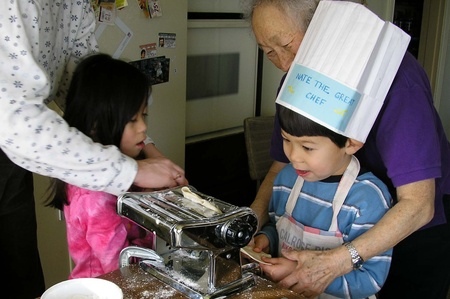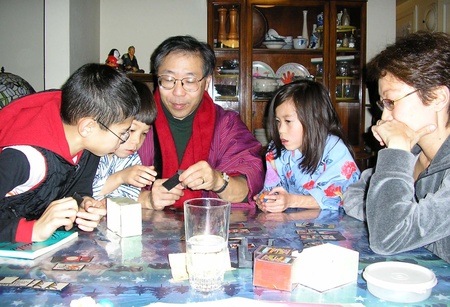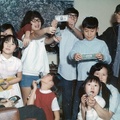Oshogatsu (New Year’s) was when our family learned the most about Japanese culture. The week before New Year’s Day, we often helped make mochi at Japanese Baptist Church (Seattle). We smoothed the mashed lumps of hot, sticky rice into little round cakes with sweet rice flour and polished the tops with the palms of our hands.
Sometime before the end of the year, we were supposed to clean the whole house (ohsoji), which rarely happened, and pay all of our bills. This way we would start the New Year clean and debt-free.
Sometimes, we spent New Year’s Eve at Grandma's house when we were little, anxiously waiting to bang on her pots and pans at the stroke of midnight. No wonder they were so dented and misshapen! My mom said that my grandma would also mop the kitchen floor and lastly, take a bath after everyone went to bed on New Year’s Eve.
A couple days before New Year’s Day, we made udon (thick wheat noodles) with Grandma from scratch. She prepared the dough with flour, warm water, and a dash of salt. The dough had to be kneaded seven times, five times, then three times, resting in between. Finally, it would get cut into smaller pieces that we would roll into long ropes. We kept rolling it between our hands or on a board, gently pulling until it was long enough to drape over the backs of chairs. Mine never got that long because they always broke.
In later years, my mom and aunts bought a pasta machine for Grandma. Some of my younger cousins would help her by cranking the handle of the machine. The fun part was catching the noodles as they were finally cut to size. Grandma then cooked them in boiling water and stored them overnight in covered baskets.
On New Year's Day, we savored eating the fat, luscious homemade udon, which Grandma warmed in broth made from the Thanksgiving turkey carcass. Noodles signify long life, as do ebi (shrimp).
We also had other favorite dishes. My sister and cousin liked kazunoko because it made loud, crunchy noises inside their heads as they ate it. They giggled at the thought that the fish eggs represent fertility. My mom liked kombu-maki (kelp roll), which symbolizes happiness. There were also kuromame (black beans) for health, renkon (lotus root) for purity, carrots and gobo (burdock root) for stability, and takenoko (bamboo shoots) and mochi for strength.
I liked the sunomono that Grandma made with cucumber, wakame (seaweed) and squid. I also looked forward to oshiruko, a sweetened azuki-bean soup warmed and served with a softened mochi cake. Grandma or my mom also prepared makizushi (rolled sushi) and inarizushi (tofu-pouch sushi). We learned to appreciate the flavors and tried to remember the symbolism of the various foods.
Grandma was from Shikoku, Japan. Her mother died of typhoid when she was only 15. At 17, she came to America as a picture bride. This meant that most of her traditional dishes she actually learned in the States from her friends or from Japanese magazines. So, her Japanese dishes had an American influence to them with the ingredients mostly purchased locally from Uwajimaya (the Japanese store) and Safeway.
One of my uncles always gave my grandma a gift certificate to Uwajimaya for Christmas. It was her favorite gift because she could buy all the ingredients for her Japanese dishes with it. Typically, the entire time that Grandma was bustling about the kitchen, Grandpa sat in his rocking chair in front of the TV, smoking his pipe.
Several years after my grandma had passed away, my mom decided that she wanted to carry on some of the New Year’s traditions. She enjoyed making udon at the end of December and inviting everyone over for a hot bowl of noodles to start the New Year.
One year she noted making 12 batches of udon, 4 balls each, for a total of 48 balls. Each ball of dough passed through the pasta machine 20 times for a grand total of 960 times! After cutting the dough into noodles, the final tally was 1008 times through the machine. Forty-nine people came over and each family had a bag of noodles to take home. She also wrote that probably 6 batches would’ve been enough; but that was so like my mom to get carried away.
On New Year’s Eve, we sometimes played Hanafuda, the Japanese flower card game dating back to Japan’s Heian era. The deck of 48 cards has twelve suits representing the twelve months of the year, each flower having a special meaning. The pine tree symbolizes strength and endurance while the crane stood for longevity and good fortune, together symbolizing hope and promise for the New Year.
The first meal of the New Year was always Japanese. Osechi ryori (traditional Japanese New Year foods) tasted healthy and was somehow cleansing, with favorable attributes represented by the symbolic food. But the backdrop was always American football, often the Rose Bowl on TV. So Japanese New Year often went hand-in-hand with football, much like Thanksgiving turkey and football.
It was always very relaxed, combining both cultures that met somewhere in between. What was important was family and being together as much as possible. Even though our Issei grandparents and Nisei parents are gone, our family still gets together twice a year for different occasions.
* * * * *
Grandma Inouye’s Udon
- Combine 3 ½ cups of flour with 1 cup of warm water and a dash of salt. Mix by hand until blended. Form dough into 3-4 balls and place in a bowl covered with a moist cloth for a few hours or overnight.
- Knead by hand or machine until smooth, 7x, 5x, 5x again, then 3x, allowing dough to rest in between. (If using a pasta machine, knead 7x at one thickness, then subsequently at desired thickness. Dough will become softer and more pliable.) Roll into long noodles by hand (see below) or cut into desired size by machine.
*By hand: Shape each ball into a long roll, then cut into slices. Shape each slice into a hotdog-shape. Line them up on a damp cloth and cover. Let rest about 1 hour. Again, take each log, roll and pull until 1/2” in diameter. Again, place ropes on a damp cloth and cover. Let stand ½-1 hour.
Place two vinyl chairs back-to-back, about a foot apart. Wipe surfaces clean. Start pulling the ropes until ¼” thick in diameter. Place them across the chairs. If they are hard to pull, let them stand longer. Be sure the cloths are barely damp; otherwise, the ropes will become soft and sticky.
Place your forearms under the stretched-out noodle and carefully lift to transfer to the boiling water. - Cook in boiling water about 10 minutes, stirring vigorously to prevent sticking. Rinse under cold water & drain. Bundle into bowl-sized bunches for storage. Cover with moist towels & store in a cool place. Warm in broth to serve. Serves 4-5 people.
*This article was originally published on January 1, 2023 in The North American Post and was modified for Discover Nikkei.
© 2023 Geraldine Shu







